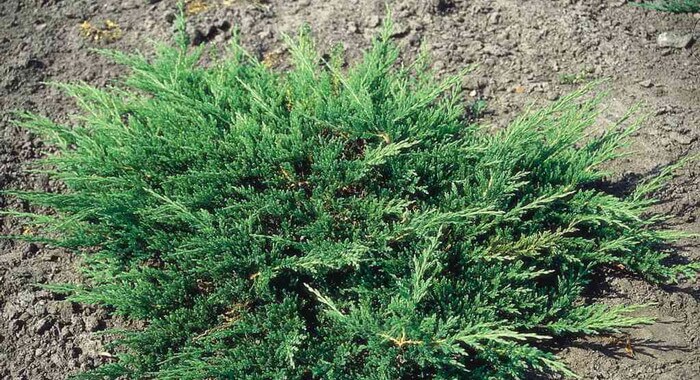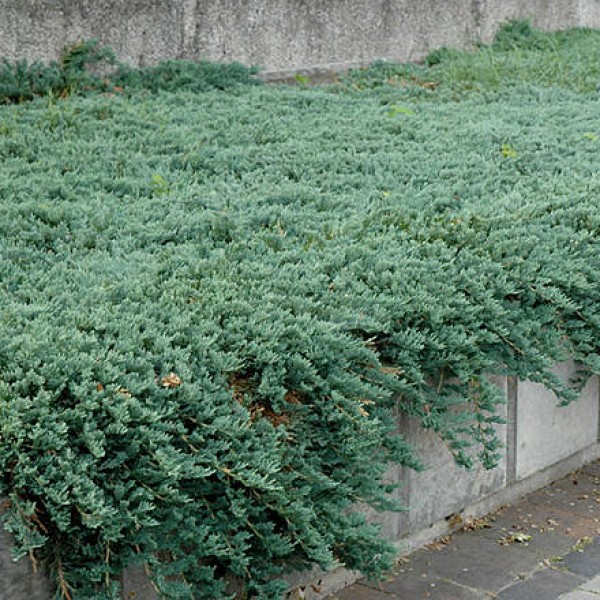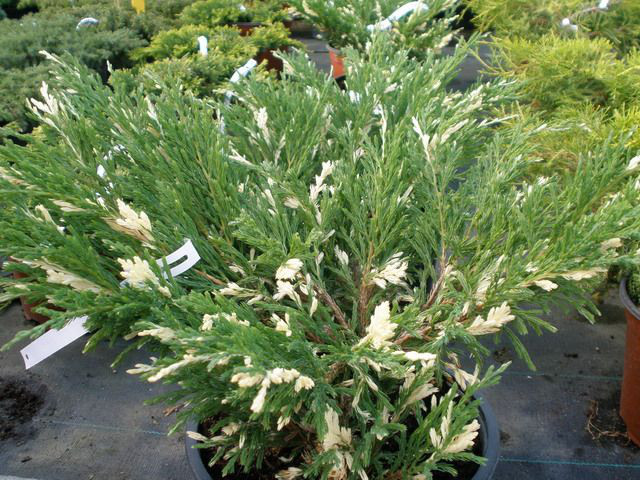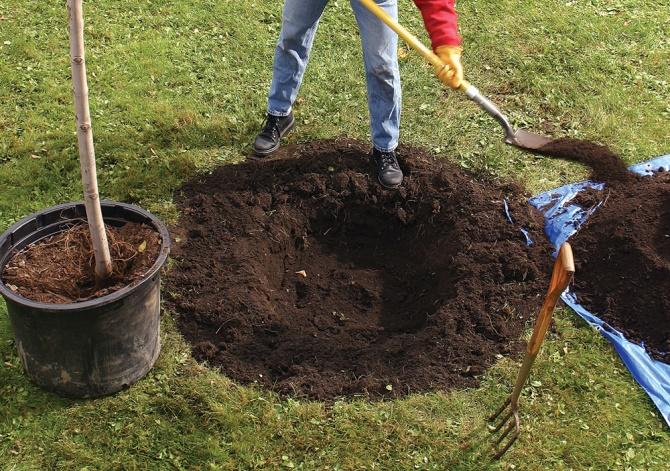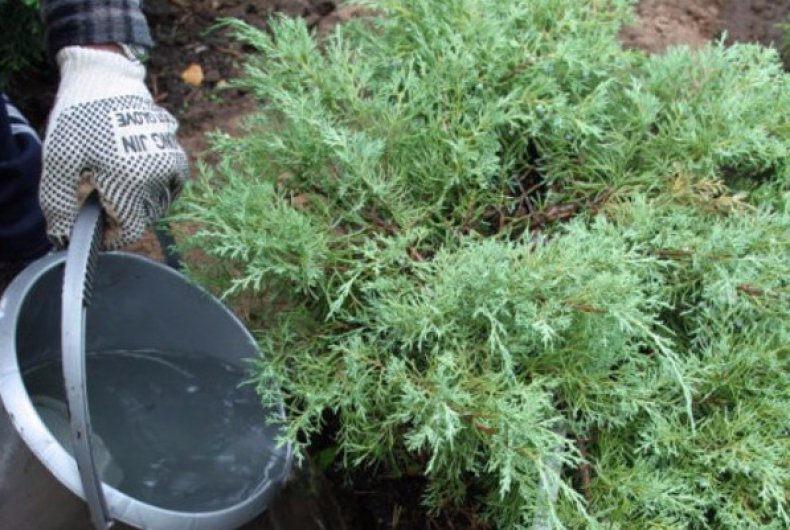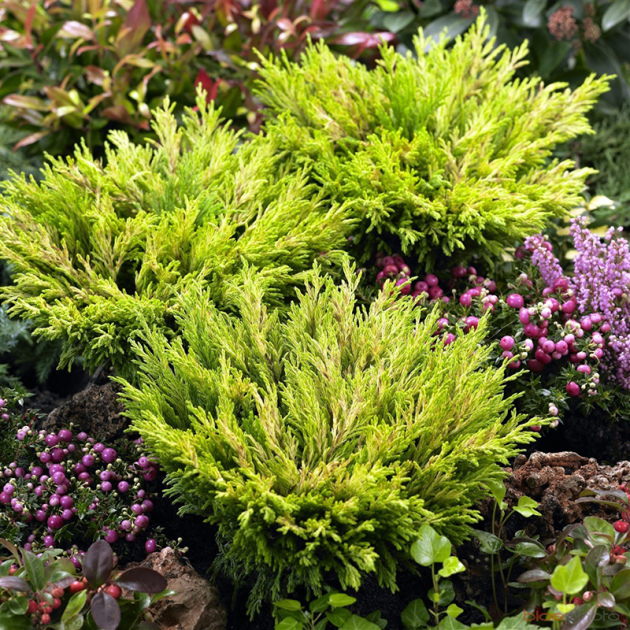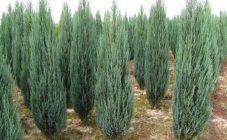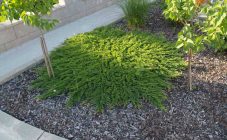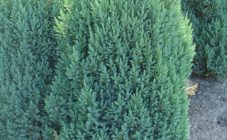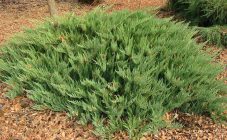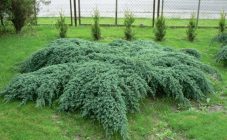Content:
Horizontal juniper is one of the most popular plants in landscape design. It is successfully combined with erect varieties of ornamental shrubs, flowers, small architectural forms. In addition, such a bush is of great ecological importance. One hectare of planting, thanks to its phytoncides, is able to disinfect a huge metropolis.
What is juniper
The horizontal juniper belongs to evergreen coniferous bushes and, as the name implies, differs in growth in width. Such a plant is called creeping. In height, depending on the variety, it can grow from 10 to 45-50 cm.The crown circumference (or, in other words, the spread of the bush) can be 1-2.5 m.
The bush grows very slowly. Its branches are very elongated. Sometimes they are covered with young growth (bright young shoots) or needles (with a maximum length of 5 cm), scales (2.5 cm long).
The color of the plant depends on the variety, but mainly the juniper bush has a green or blue-green hue. There are bushes of silver and yellow color. As autumn approaches, the plant often changes its color to brown or dark purple.
The fruit of the bush is a cone berry that ripens within 2 years. As a rule, it has a darker shade.
Popular varieties
Experts identify more than 100 ornamental varieties of horizontal juniper. Below is a comparative description of the most popular of these.
Juniper Golden Carpet
The variety was bred back in 1992. The variety is especially popular with gardeners, although it grows slowly compared to other varieties. The maximum plant growth is 30 cm in height. As for the branches, they can grow up to 1-1.5 m. This is a rather flat bush. The needles have the shape of green needles closer to the base and yellow at the end. Sensing the approach of frost, the plant changes the color of the needles to dark brown.
Ice Blue Juniper
This recumbent bush is the pride of the 1967 American selection. The height of this plant very rarely exceeds 15 cm. The diameter of the bush is 2 m on average. The crown is dense, making the whole bush look long and thick. The needles of this variety look like scales. It is blue-green in summer and purple-blue in winter. Growing densely on the ground, the bush creates a natural green rug. The fruit of the bush is a small blue cone-berry, up to 7 cm in size.
Juniper Nana
The variety was bred by specialists from the United States back in 1922. This is a low bush, which can rise to a maximum of 0.2-0.3 m in height.However, it grows well in width - up to 1.5 m.In one year, Nana spreads about 15 cm.The shoots of the plant are short, but enough tough. At the end, they are slightly raised up, very tightly located to each other. This makes it possible to very successfully combine the plant with stone compositions. The needles of a juniper are acicular. Has a bluish gray color.
Juniper Andorra Variegata
An evergreen and very compact plant.As tall as Andorra
Compact, can grow up to 0.4 m, in width - up to 1.5 m. The bush has a flat, round, cushion-like shape. A feature of the plant is cream-colored spots on dark green twigs. The bark of the plant is smooth and tender at a young age, but over time it begins to darken and crack. It grows slowly: 10 cm in height and width per year.
Juniper Blue Forest
A very special variety is the Blue Forest ground cover juniper. In comparison with many other plants of its kind, it is quite tall: it can grow up to 40 cm in height. As a rule, the bushes of the variety are not wide - up to 0.5 m. The main branches are short, but flexible. They are covered with small needles-scales. The silvery blue color of the plant contributes to its attractiveness and allows you to create special design compositions.
Agricultural technology of cultivation
Although horizontal juniper is a relatively unpretentious crop, not all of its varieties have the same needs. Therefore, it is advisable to compare the conditions of planting and care for several varieties.
The golden carpet juniper loves sunny places most of all. If it is planted in the shade, then it loses its golden color, becomes darker. The soil must be alkaline or slightly acidic for it. It can withstand fairly severe frosts and drought of the soil, but is sensitive to dry air. The optimal planting pattern is 0.5-2 m between individual bushes. When planting plants, you need to take into account its size and age. A planting hole for adult shrubs can be up to 70 cm deep. When planting, the root collar should not be buried in the ground.
Caring for the plant includes abundant watering during the first week after planting, systematic watering during dry periods, shallow loosening (especially when the plant is still young), annual fertilization (for example, with nitroammophos or universal means).
Planting of Ice Blue juniper is not significantly different. The bush is unpretentious to the soil, but grows better in acidic and alkaline areas. He loves sandy loam and loamy bush. Just like Golden Carpet, Ice Blue should have enough light, however, unlike the previous version, it can grow well in partial shade. Full shade harms the plant - it loses its attractive appearance, becomes dull. The owner needs to make sure that there are no weeds in the diameter of 40-90 cm from the trunk. Depending on the season and soil moisture, the plant needs to be watered 1 to 3 times a week. The optimal proportion of water is 10-30 liters per adult bush. In spring, the plant needs fertilizing with nitrogen fertilizers, in winter - with potash, in summer - with phosphorus.
Juniper Procumbens Nana grows best in light sandy loam areas. Slight partial shade is allowed, but full shade harms the plant. Soils with a slightly acidic and neutral reaction are most suitable for the plant. The optimal distance between Nana bushes should be between 0.5 and 2 m, depending on the age and size of the plant.
The bush should be added during the dry season, 1-2 times a year can be fed with universal means. Bushes do not withstand stagnant water and excessive fertilization.
The common variegated juniper grows well on drained sandy loam and acidic soils enriched with vitamins. If possible, it is better to plant the plant in a sunny place. Penumbra is also possible, but not the best option. Lands in the same way as Golder Karpen. The plant needs frequent but moderate watering. From time to time (especially for young plants) loosening should be carried out.
Forest Blue grows well in moderately dry areas. It is best suited to soils with an alkaline or acidic reaction.Like many other varieties of juniper, an adult bush should be planted to a depth of 70 cm. Given the elongated shape of the plant, it is allowed to place the bushes with a distance of 0.5-1 m from each other. It is necessary to water the plant taking into account the soil moisture. For this variety, sanitary pruning is recommended two to three times a year.
Advantages and disadvantages of the variety
Like all other plants, juniper has its own advantages and disadvantages. Analyze them in the most correct way based on specific examples.
As the description of the variety in the specialized literature makes it clear, the horizontal juniper Golden Carpet receives high praise for:
- its unusual green-golden color;
- the density of the needles;
- moisture resistance and frost resistance;
- unpretentiousness to the soil.
The main disadvantages of the plant are:
- very slow growth - in 10 years of its life, the plant can grow up to 0.1 m in height and up to 1.2 m in width;
- the need for good natural light.
Ice Blue boasts a relatively unassuming grooming and thick, soft needles. Unlike other varieties of horizontal juniper, this one does not require cutting at all. The main disadvantage of the plant is the tendency to some plant diseases, including shute, fusarium, alternaria, juniper rust.
The Nana variety is most appreciated for its unrivaled combination with rocky compositions. The bush can grow well in different climatic zones and on different soils. Its main disadvantage is its tendency to decay during the period of stagnant melt water.
The main advantage of the Andorra Variegat juniper is its compactness. The plant is easily transplanted and is well accepted in new sunny areas. White blotches distinguish this variety from others, which makes it interesting to combine an ornamental bush with other plants.
Blue Forest is a frost-resistant plant. Due to its growth, it compares favorably with the overall garden composition. The plant actually never gets sick and does not require special care. The bush does not change its rich color even in winter. The plant can be grafted onto a stem. There are no serious downsides. His only "but" can be called the need for treatment from a spider mite.
Use in landscape design
Landscaping is especially interesting and refined if you use a horizontal view of a juniper in its creation. Designers in the Scandinavian and English styles manage to create interesting compositions. The first is distinguished by such elements as: the severity of the lines, the use of juniper of yellow and yellow-green colors. A combination of different heights of junipers will be appropriate for the Scandinavian style.
It is difficult to imagine landscape design in the English style without such a coniferous culture as juniper. The best option for this case would be bushes of the correct shape (for example, balls or squares). Plants with blue and green needles should be preferred. In "English" landscape, horizontal juniper will not be the basis for the design, however, it will help to complement the overall landscape.
Supporters of the Japanese (oriental) style in landscape design should also think about planting a juniper. The severity of the forms in combination with contrasting bright colors will help to correctly place accents. The stone islands go well with various varieties of Japanese-style horizontal junipers.
Independent use of horizontal junipers in landscape design looks very monotonous and uninteresting. Experts recommend combining these plants with perennial flowers, undersized trees and other ornamental shrubs.So, against the background of rocky territories, horizontal juniper goes well with heathers and dwarf barberries.
Different varieties of coniferous bushes are perfectly combined with mountain pine, undersized species of Christmas trees, weeping larch. If you want to make a combination with stones, then it is better to opt for boulders, granite chips.
These conifers are also suitable for creating: alpine hills, rocky gardens, rock gardens, rockeries, arranging retaining walls, hedges, curbs, terraces. Perfectly coniferous undersized bushes are suitable for landscaping the coastal zone.
